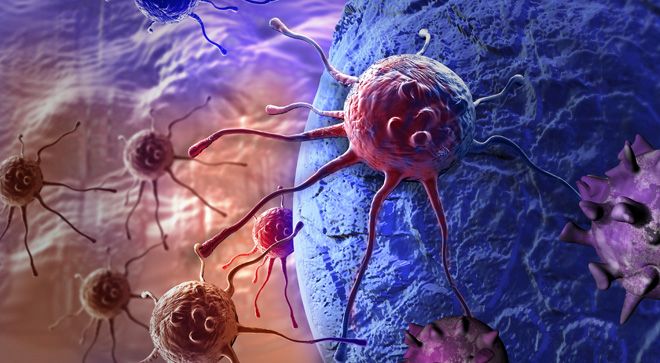Among patients with grade 1 (least aggressive) or grade 2 (more aggressive than grade 1) somatostatin receptor-positive gastroenteropancreatic neuroendocrine tumors (GEP-NETs), the phase 3 COMPETE trial presented positive topline data of patients treated with 177Lu-edotreotide (ITM-11). Patients treated with 177Lu-edotreotide had a significantly longer median progression-free survival compared to those receiving Afinitor
The findings were announced in a news release from the drug’s manufacturer, Isotope Technologies Munich.
“COMPETE is the first pivotal trial comparing a radiopharmaceutical drug candidate to a targeted molecular therapy without the routine use of accompanying somatostatin analogues in this GEP-NET patient population. These data show unequivocal support for 177Lu-edotreotide's potential benefit in extending [progression-free survival],” Dr. Capdevila, senior medical oncologist at Vall d'Hebron University Hospital, Barcelona, said in the news release. “Additionally, 177Lu-edotreotide's convenient dosing schedule and favorable safety results reinforce its potential as a compelling new treatment option.”
Glossary:
Progression-free survival: time a patient lives without disease progression during treatment.
Overall survival: time from diagnosis or treatment start to death.
Somatostatin receptor-positive: tumors expressing somatostatin receptors, targeted by 177Lu-edotreotide.
Myelodysplastic syndromes: blood disorders, reported as a side effect of 177Lu-edotreotide.
Ki-67: marker of tumor cell proliferation; 20% or less indicates lower-grade tumors.
Non-carrier-added lutetium-177: purified form of lutetium-177 used in 177Lu-edotreotide for higher potency.
Nephroprotective amino acid solution: protects kidneys during 177Lu-edotreotide therapy.
Dosimetry: measurement of radiation dose in tumors and healthy tissue.
Objective response rate: percentage of patients with tumor shrinkage or disappearance.
New drug application: request to the FDA to approve a new drug.
Somatostatin analogues: drugs mimicking somatostatin, often used with other treatments for neuroendocrine tumors.
Patients treated with 177Lu-edotreotide had a significantly longer median progression-free survival of 23.9 months compared to 14.1 months for those receiving Afinitor (everolimus). Interim median overall survival was higher for 177Lu-edotreotide compared to Afinitor, though the difference was not conclusive (63.4 versus 58.7 months).
Regarding safety, a lower proportion of patients experienced treatment-emergent side effects related to study medication with 177Lu-edotreotide (82.5%) versus Afinitor (97%); one grade 2 (moderate) serious side effect of myelodysplastic syndromes related to 177Lu-edotreotide was reported.
“The COMPETE results represent a major step forward in the development of new treatment options for people living with progressive, inoperable GEP-NETs,” Dr Jonathan Strosberg, past president, North American Neuroendocrine Tumor Society and chair, GI Research Program, Moffitt Cancer Center and Research Institute in Tampa, Florida, said in the news release. “By extending progression-free survival by almost ten months compared to standard of care in this trial, 177Lu-edotreotide showed the potential to significantly improve the treatment paradigm for physicians and their patients.”
177Lu-edotreotide was well-tolerated, with no unexpected treatment-emergent side effects. Ongoing analyses include objective response rate, subgroup evaluations, quality of life measures and dosimetry, which are expected to be presented at upcoming medical conferences. Isotope Technologies Munich plans to submit a new drug application to the Food and Drug Administration (FDA) in 2025, according to the release.
The COMPETE trial is a phase 3, randomized, controlled, open-label study that enrolled 309 patients with inoperable, progressive grade 1 or 2 somatostatin receptor-positive neuroendocrine tumors of gastroenteric or pancreatic origin (Ki-67, 20% or less). Conducted in Europe, the United States, Australia and South Africa, the trial aimed to evaluate the efficacy and safety of 177Lu-edotreotide compared to Afinitor.
177Lu-edotreotide, a radiopharmaceutical, combines non-carrier-added lutetium-177 and edotreotide, a somatostatin receptor agonist. It is the first such therapy tested in the GEP-NET population using non-carrier-added lutetium, which offers higher isotopic purity than carrier-added lutetium, as per the release.
Patients were randomly assigned to receive 7.5 GBq of 177Lu-edotreotide with a nephroprotective amino acid solution every three months for up to four cycles, or 10 milligrams of daily Afinitor for up to 30 months or until disease progression. The 177Lu-edotreotide arm included 207 patients, while 102 patients were on the Afinitor arm. Dosimetry was used to assess absorbed doses in tumors compared to healthy tissue to enhance the safety and efficacy of the treatment.
For more news on cancer updates, research and education, don’t forget to subscribe to CURE®’s newsletters here.





